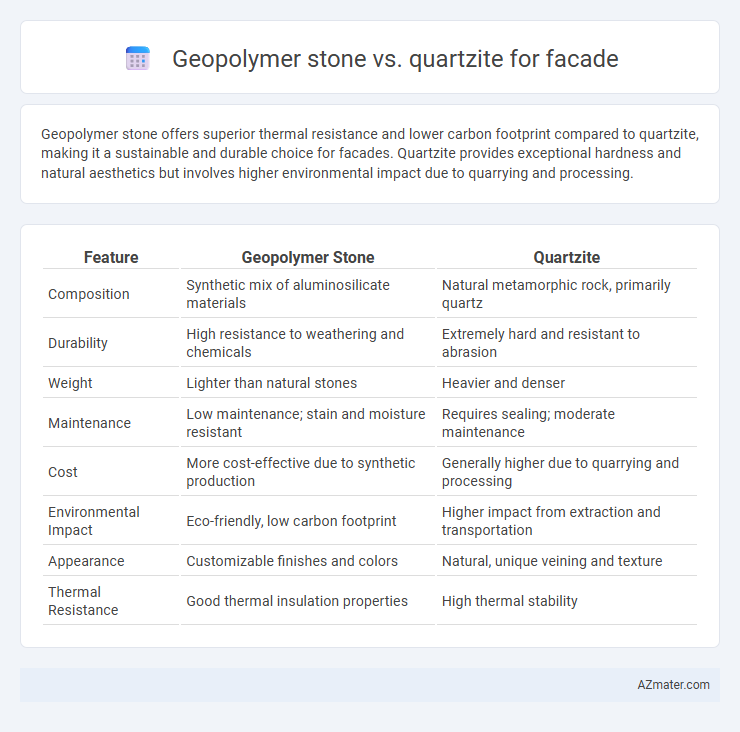Geopolymer stone offers superior thermal resistance and lower carbon footprint compared to quartzite, making it a sustainable and durable choice for facades. Quartzite provides exceptional hardness and natural aesthetics but involves higher environmental impact due to quarrying and processing.
Table of Comparison
| Feature | Geopolymer Stone | Quartzite |
|---|---|---|
| Composition | Synthetic mix of aluminosilicate materials | Natural metamorphic rock, primarily quartz |
| Durability | High resistance to weathering and chemicals | Extremely hard and resistant to abrasion |
| Weight | Lighter than natural stones | Heavier and denser |
| Maintenance | Low maintenance; stain and moisture resistant | Requires sealing; moderate maintenance |
| Cost | More cost-effective due to synthetic production | Generally higher due to quarrying and processing |
| Environmental Impact | Eco-friendly, low carbon footprint | Higher impact from extraction and transportation |
| Appearance | Customizable finishes and colors | Natural, unique veining and texture |
| Thermal Resistance | Good thermal insulation properties | High thermal stability |
Introduction to Geopolymer Stone and Quartzite
Geopolymer stone is an engineered material made from industrial by-products like fly ash and slag, offering high durability, chemical resistance, and eco-friendly benefits for facade applications. Quartzite is a natural metamorphic rock composed mainly of quartz grains, prized for its impressive hardness, weather resistance, and distinctive crystalline texture. Both materials provide strong, long-lasting facade surfaces, with geopolymer stone emphasizing sustainable production and quartzite emphasizing natural aesthetics and proven resilience.
Composition and Manufacturing Process
Geopolymer stone is composed of industrial by-products like fly ash or slag combined with alkaline activators through a low-temperature chemical process that creates a durable, eco-friendly material. Quartzite is a natural metamorphic rock primarily made of quartz formed under high temperature and pressure, then cut and polished for facade use. The manufacturing of geopolymer stone involves synthetic chemical synthesis offering uniformity and environmental benefits, whereas quartzite relies on natural geological processes resulting in unique textures and color variations.
Aesthetic Differences and Design Versatility
Geopolymer stone offers a highly customizable surface with a wide range of colors, textures, and patterns, enhancing facade design versatility compared to naturally uniform quartzite. Quartzite's natural crystalline appearance provides a unique, high-end aesthetic with subtle color variations, ideal for sophisticated designs seeking organic beauty. The engineered nature of geopolymer stone allows for consistent quality and innovative shapes, while quartzite's durability and natural veining appeal to traditional, timeless architectural styles.
Durability and Weather Resistance
Geopolymer stone demonstrates exceptional durability and superior resistance to weathering compared to quartzite, making it an ideal choice for facade applications in harsh climates. Its synthetic composition offers enhanced resistance to UV radiation, moisture infiltration, and freeze-thaw cycles, preserving structural integrity and appearance over time. Quartzite, while naturally hard and attractive, is more susceptible to surface erosion and color fading under prolonged exposure to environmental stressors.
Environmental Sustainability and Eco-Friendliness
Geopolymer stone offers superior environmental sustainability compared to quartzite due to its low carbon footprint and utilization of industrial by-products like fly ash and slag, reducing landfill waste and conserving natural resources. Quartzite extraction involves extensive mining, leading to habitat disruption and higher energy consumption, whereas geopolymer production emits significantly less CO2 and requires less water. Choosing geopolymer stone for facades supports eco-friendliness by promoting circular economy principles and reducing reliance on non-renewable natural stone.
Cost Comparison and Long-Term Value
Geopolymer stone offers a cost-effective alternative to quartzite for facades, typically reducing initial expenses by 20-40% due to lower material and manufacturing costs. Quartzite provides superior natural stone durability and weather resistance, which can translate to lower maintenance costs over a 20- to 30-year lifespan. When evaluating long-term value, geopolymer stone's affordability and customizable aesthetics make it ideal for budget-conscious projects, while quartzite's high resale value and timeless appearance benefit premium constructions seeking extended durability and prestige.
Installation and Maintenance Requirements
Geopolymer stone offers lightweight installation and requires minimal maintenance due to its resistance to weathering and pollutants, making it ideal for facades in harsh environments. Quartzite, while durable and aesthetically appealing, demands specialized handling during installation because of its weight and brittleness, and routine sealing is necessary to prevent staining and surface degradation. The choice between the two materials hinges on balancing ease of installation with long-term upkeep in facade applications.
Thermal and Acoustic Performance
Geopolymer stone offers superior thermal insulation with a lower thermal conductivity of approximately 0.15-0.25 W/mK compared to quartzite's 2.5-5.5 W/mK, resulting in enhanced energy efficiency for building facades. Acoustically, geopolymer stone provides better sound absorption due to its porous microstructure, reducing noise transmission more effectively than the dense, crystalline quartzite. These properties make geopolymer stone a preferred choice for facades requiring improved thermal regulation and noise control.
Application Suitability for Facades
Geopolymer stone offers superior chemical resistance and lightweight properties, making it highly suitable for modern facade applications that demand durability and easy installation. Quartzite, known for its natural hardness and weather resistance, excels in facades requiring high mechanical strength and aesthetic appeal with a natural stone finish. Both materials perform well in external cladding, but geopolymer stone's engineered consistency provides better customization options for complex facade designs.
Conclusion: Choosing the Right Material for Your Facade
Geopolymer stone offers superior environmental benefits, including lower carbon emissions and enhanced durability, making it an excellent sustainable choice for modern facades. Quartzite provides exceptional hardness and natural aesthetics with high resistance to weathering and wear, ideal for traditional and high-end architectural designs. Selecting between geopolymer stone and quartzite depends on balancing sustainability goals with desired visual impact and long-term performance requirements for your facade.

Infographic: Geopolymer stone vs Quartzite for Facade
 azmater.com
azmater.com